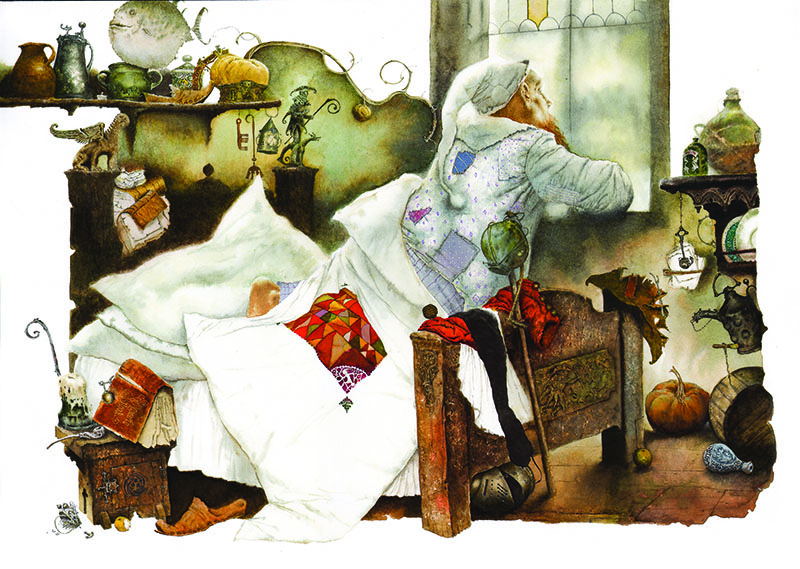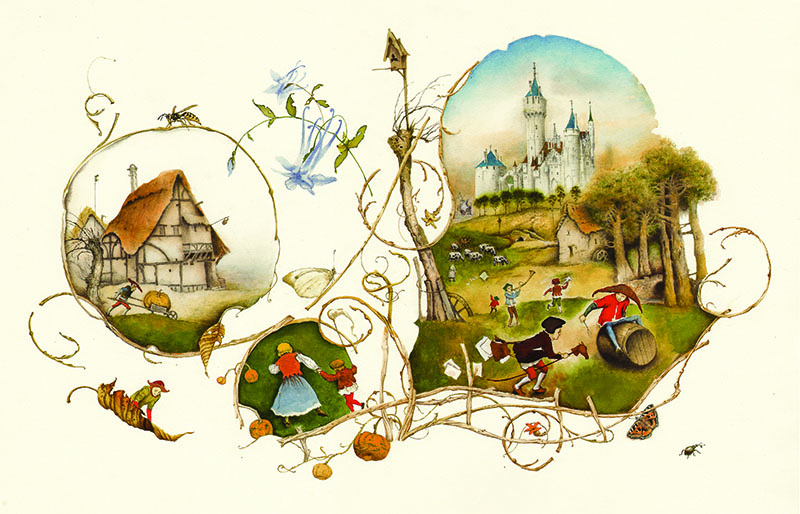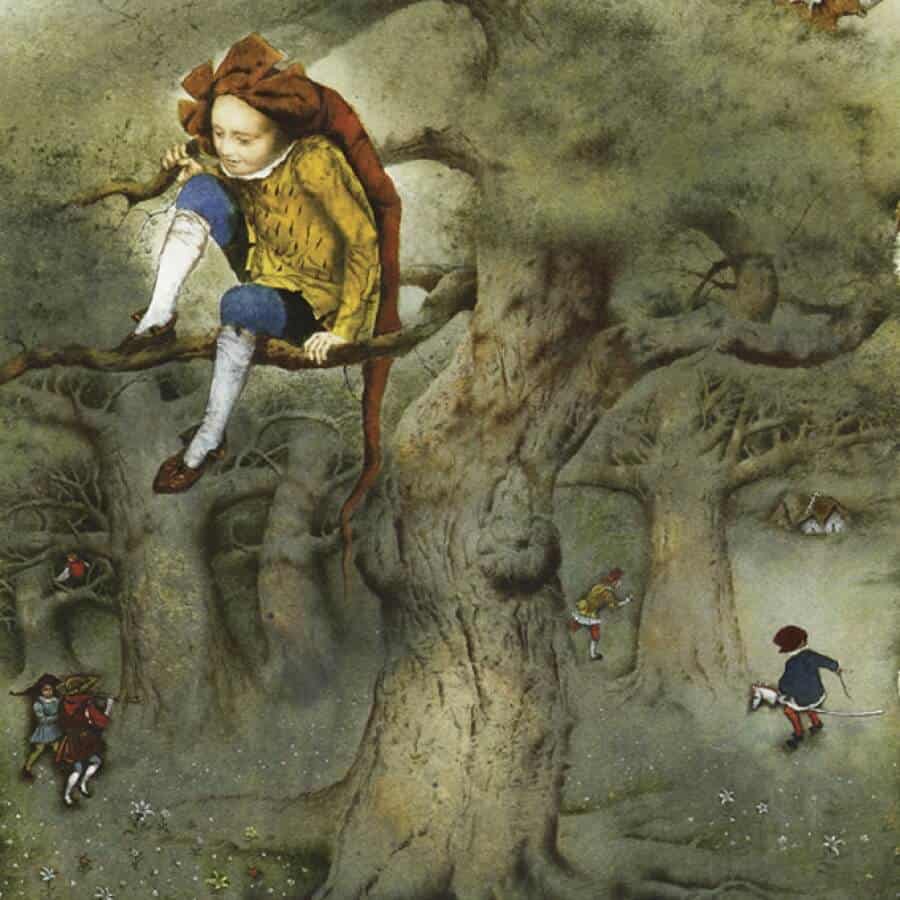Interview with a Belorussian artist about fairy tales, growing up, drawing technique and dusty couches.

Vladimir Dovgialo is a renowned Belorussian artist who specializes in illustrating fairy tales for children. He has not only received a great number of awards and titles, but he has also captured the hearts of thousands of fans from around the world. He has always worked in water color, a very capricious medium, and he has mastered it to perfection. Characters in juvenile books, as created by Vladimir Dovgialo, radically alter our concept of illustration for children’s books. “A man who immediately understood that drawing is his calling in life”, that is how he introduced himself at the beginning of our interview.

Vladimir, there is something extraordinary, something magical in your illustrations. How did you acquire this style?
Certainly, I didn’t work it out in one day, I had been experimenting with different types of texture, paper and material for a long time before I reached the effective level of graphical solution for illustrations which I, modestly speaking, currently possess.
Fairy tales for children are imbued with the belief in miracles. Do you believe in miracles and magic? Do you have any favorite authors of fairy tales?
Of course! Certainly, I believe in magic and fairy tales, otherwise I just wouldn’t have engaged in the craft of illustration. There is always a place for a fairy tale in our lives, just as there is for an act of valor. Perhaps, it is unlikely that someone would be able to create something better than folk tales. They have an inexhaustible source of plots, relations, and even morals. I doubt that it can be substituted with something else. Speaking of authors, my favorite ones are the Grimm Brothers and Oscar Wilde.

Fairy tales are written not only for children. Do you also illustrate tales for adults, and are they any different from the ones for kids?
That is a very good question, thank you for asking. Many people think that illustrators produce only books for children. Nothing could be further from the truth! In fact, illustrators make books for themselves, for that childish part of their personality. Therefore, if you really try to bring an artist who makes children’s books into the open, sooner or later he will confess to making those books for himself, from early childhood. He creates the books he would like to read and thumb through, books in which he would like to live. It is a complicated existential line between childhood and adulthood that can not be ever drawn. And, perhaps, illustrations are the exact place where this line is simply being erased. It is hard to tell whether those are fairy tales for children or adults, it’s more likely that they are for everybody.
It often happens that children find stylish and detailed book illustrations less appealing than colorful and simple ones like, for instance, pictures in Disney books. How do children perceive your drawings?
Well, you should certainly ask children about that … Laughs … However I agree that, on the one hand, technical skillfulness can exhaust the drawing to such a degree that you simply wouldn’t want to live in it, regardless of its incredibly elaborated details etc. It would be so dried out that it would be transformed from art into craft. It has to be avoided, but, at the same time, the oversimplification and articulation of a drawing is appropriate only if some well-formed style requires such measures. I’m not against the refraction of graphics for illustration; it can be brutal, as well as incredibly sophisticated. It is a matter of persuasiveness. I reckon that it is necessary to constantly work on this issue in order to consolidate these “scissors” of technical workup and, put it that way, spiritual component, so someone would want to live in this drawing, enter it and stay there for some time.
Many people have a hard time understanding the exact definition of a good illustration. How should one cultivate good taste, learn to discern and appreciate?
As for this issue, I think it is necessary to rely on global practice and search for an anthology of the best illustrators in the world. Nowadays, it is not hard to find works that represent various countries and cultures. Every country has given the world at least a few dozen, or a hundred, decent or even ingenious illustrations. Over the past 100 or 150 years, a fair quantity of brilliant material has appeared, particularly in the area of water color drawing.
Are there any artists whom you admire?
Certainly, first and foremost I would like to name Arthur Rackham and Edmund Dulac. Those two artists lived in the early 20th century and enriched the world of illustration with, in my opinion, unsurpassable images. Surely, nowadays there are plenty of brilliant masters of illustration, and probably I shouldn’t try and remember all of them in order not to offend someone whom I might forget.

What advice can you give to students who want to draw just as well as you?
My advice to students is that they should work tirelessly and even force themselves to do it, because the human psyche is designed in such way that it strives towards homeostasis, to equilibrium. In order to work, you have to throw yourself off balance, you have to commit yourself to drudgery, do things which sometimes you are unwilling to do. It can be compared with going out for sports, when a person would rather lie on the couch, drink something like beer and watch TV. It is easier for him to find his equilibrium that way, but would it be useful for him? What if it weren’t good? Perhaps, he should go outside and shower in cold water, do some exercises, do 50 chin-ups, 120 push-ups, and it will be for the benefit of his health, though hardly a pleasant activity. The same goes for work, you don’t have to spend time searching for inspiration, it will never come because it is a myth. Actually, it is all about meticulous work, not forcing yourself, because duress and creativity are not compatible. However, it is crucial to give impulse to the creative energy in order to come to a solution for a vital task.
Some wise man said, “Do your thing, and the money will come along with it.” I think that spending your life on something that gives large profits but no pleasure is rather pointless. Therefore, I would advise immersing yourself in your favorite job! Also, I can recall an old Jewish proverb that proves my point, “If man’s destiny is to draw, he will draw even with a fork on water.” My experience suggests that it is possible to teach almost any person how to draw. It doesn’t matter whether we are talking about a janitor, a tram driver, or an ex-con. If a person has a huge desire, he can develop skills. The interest the wider audience would have in such art, surely, would also be related to this person’s mental world.

All children have dreams, and at some point their dreams come true or not. Did you have a childhood dream? And do you have a dream now?
Life without a dream is insipid and sad. It’s like looking at a dusty sofa that stands in the corner of a shed at the end of August. It seems to me that a person has a goal, if not a dream, that he pursues right to his deathbed. Like any normal child, I had a lot of dreams. Most of them came true, and I don’t regret for a second the time I’ve spent to become the professional that I am now, in other words, an artist, an illustrator and a designer. I reckon that it is important to correctly formulate your dream, if it is appropriate to give such advice, although I am not disposed to giving advice to anyone.
This article was originally published in Youth Time print edition, 31th issue. Click here to check the content of the issue, subscribe here.
Support us!
All your donations will be used to pay the magazine’s journalists and to support the ongoing costs of maintaining the site.
Share this post
Interested in co-operating with us?
We are open to co-operation from writers and businesses alike. You can reach us on our email at [email protected]/[email protected] and we will get back to you as quick as we can.









